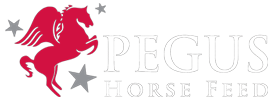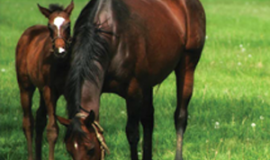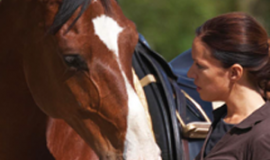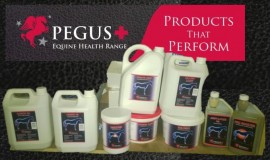The War Against Obesity Who doesn’t love to see a herd of shiny-coated horses grazing greedily in a sea of green grass? Turns out, there are quite a few people, including authorities on equine welfare who are keen for the equine community to recognize and appreciate the link between obesity and health hazards. “The issue of overweight horses is an important health risk that has become more and more prevalent over recent years,” says Sam Chubbock, BSc (Hons), Right Weight manager at World Horse Welfare (www.worldhorsewelfare.org/rightweight), in Norfolk, U.K. “Overweight…
Pegus News
A critical period for broodmares
A critical period for broodmares Spring and early summer are a critical period for broodmares. During this time, they give birth and start lactation (milk production). In the same period, they are also covered again and hopefully become pregnant. To obtain the best of results, i.e. a healthy foal with good overall development, and a broodmare that milks well and becomes pregnant again when covered, owners must provide a well-balanced and highly digestible ration. Nutritional needs change during the different phases of a broodmare’s life. Before the first mating,…
Horses on summer pasture
Horses on summer pasture Summer is grazing time and we have to monitor closely how well our horses are doing and how well the quality and quantity of their pasture suit them. The ideal is that the quality of pasture should enable it to cover horses’ nutritional needs. Poor pasture will lead to the development of thin horses, while good pasture will eventually result in fat horses. The latter is the most common problem for many When horses are on pasture day and night, they can graze efficiently for anything…
Horses Need Salt
We have come to August, and it is summer. This means that your horses need more salt because of the heat, particularly when exercised heavily. A reduction in the fluid volume of the body quickly impairs the performance of horses. The water in the body, which constitutes 60-70% of body weight, has about 10 grams of dissolved salts (minerals) per liter. The salts contribute in an essential way to the functional properties of the body fluids. When salts are dissolved in blood plasma and cell fluid we refer to them…
What quality roughage should we buy for our horses?
When we buy roughage it is important to purchase a quality that suits the particular horses we have. Ponies and horses that tend to get fat should be fed forage with a lower energy content than that for young horses, broodmares and horses in training. Whether we choose hay or haylage is of major concern, but nutrient content and hygienic quality will always be crucial. In rations for horses there should be at least 1.5 kg forage dry matter per 100 kg body weight. This is important both for maintaining…
Vitamin E and Selenium protect cells from oxidative damage
Vitamin E and Selenium protect cells from oxidative damage Vitamin E and selenium function jointly in protecting body cells from oxidation-induced damage. Low levels of selenium can partly be replaced by higher levels of vitamin E and vice versa, but they can never totally replace each other. Selenium deficiency is a constant threat where soils are low in selenium, as in Scandinavia and the British Isles. selen-vitaminE Biological oxidation In order to extract the chemical energy bound in organic nutrients like fat and carbohydrate, all animals use oxygen from the…
Vitamin D and the horse ?
Vitamin D? Vitamin D is vital for calcium homeostasis in animals and man. A deficiency may lead to bone deformities, commonly called rickets, resulting from decreased concentrations of calcium and phosphorus in cartilage and bone. The vitamin is found as vitamin D2 (Ergocalciferol) in plants and as vitamin D3 (Cholecalciferol) in feeds of animal origin, especially fish. The two forms, D2 and D3 have similar biological activity; 1 µg of D2 or D3 equals 40 international units (IU) vitamin D. During summer, exposure to sunlight leads to production of vitamin…
Starch in horse feed rations
There is a long tradition of using grains and cereal-based concentrates, especially those derived from oats and barley, in horse rations. Such ingredients are commonly an important part of rations for work horses and horses in training, since these have increased demands for energy which are difficult to meet from forage alone. Oats are commonly fed whole or crushed, while barley and other grains are main ingredients in concentrate mixtures, whether in the form of pellets/nuts or muesli/mix. The distinctive thing about grains is that they contain about 50% starch and…







